ACCT6003: Financial Accounting Case Study on Asset Valuation Methods
VerifiedAdded on 2022/09/14
|13
|1200
|20
Report
AI Summary
This report delves into the intricacies of accounting principles and policies, particularly focusing on the revaluation and impairment of non-current assets. It examines the application of AASB 1041 for revaluation, highlighting the shift towards fair value accounting and the concepts of revaluation increments and decrements. The report contrasts revaluation with impairment losses under AASB 136, emphasizing their distinct treatments. Furthermore, it provides a comparative analysis of the cost model and revaluation (fair value) model, discussing their implications for financial statement presentation. The report concludes with a recommendation for Jasper Ltd., suggesting the adoption of the revaluation model to ensure a true and fair representation of its financial position. The report is supported by several references to academic literature.
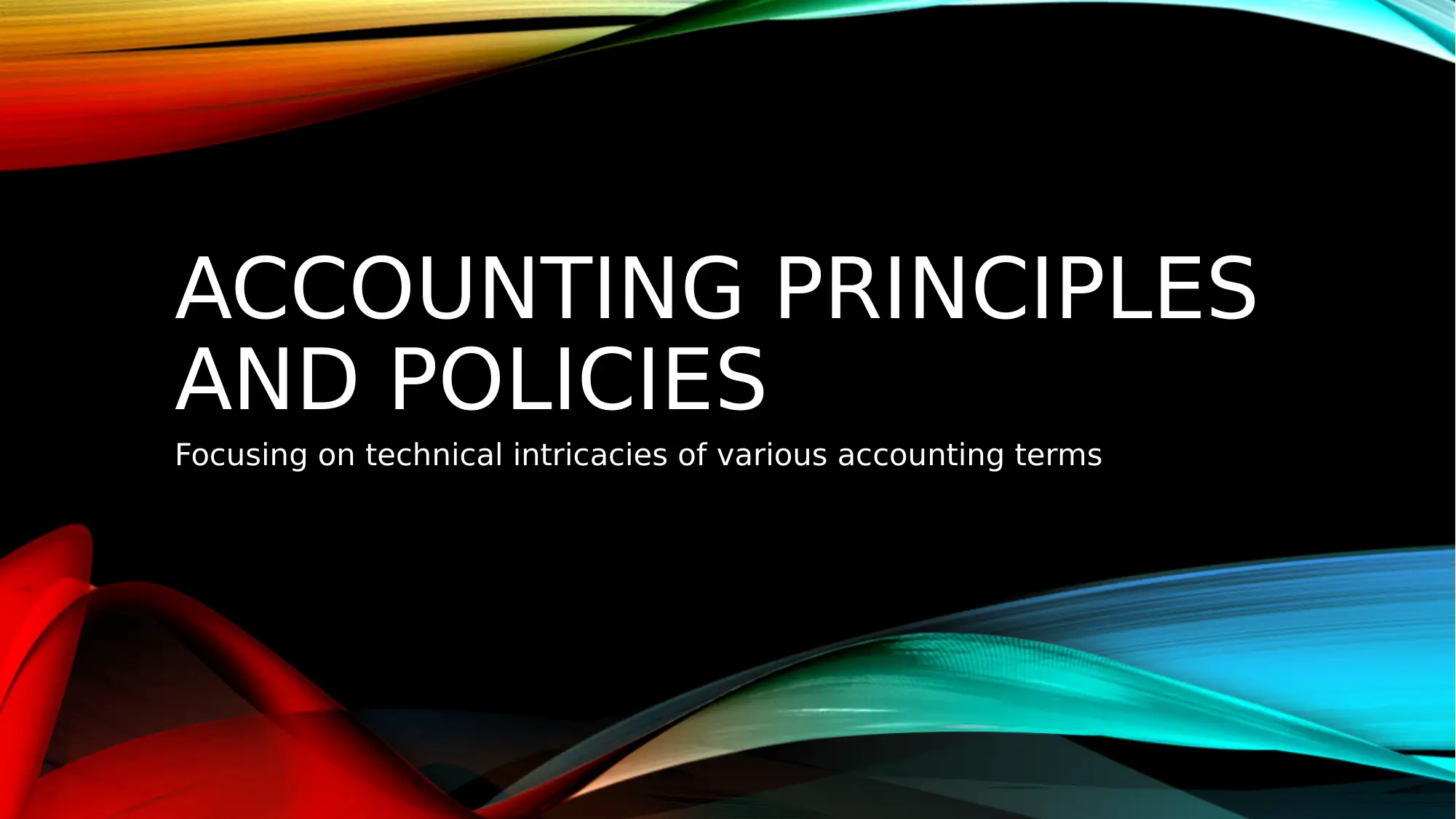
ACCOUNTING PRINCIPLES
AND POLICIES
Focusing on technical intricacies of various accounting terms
AND POLICIES
Focusing on technical intricacies of various accounting terms
Paraphrase This Document
Need a fresh take? Get an instant paraphrase of this document with our AI Paraphraser
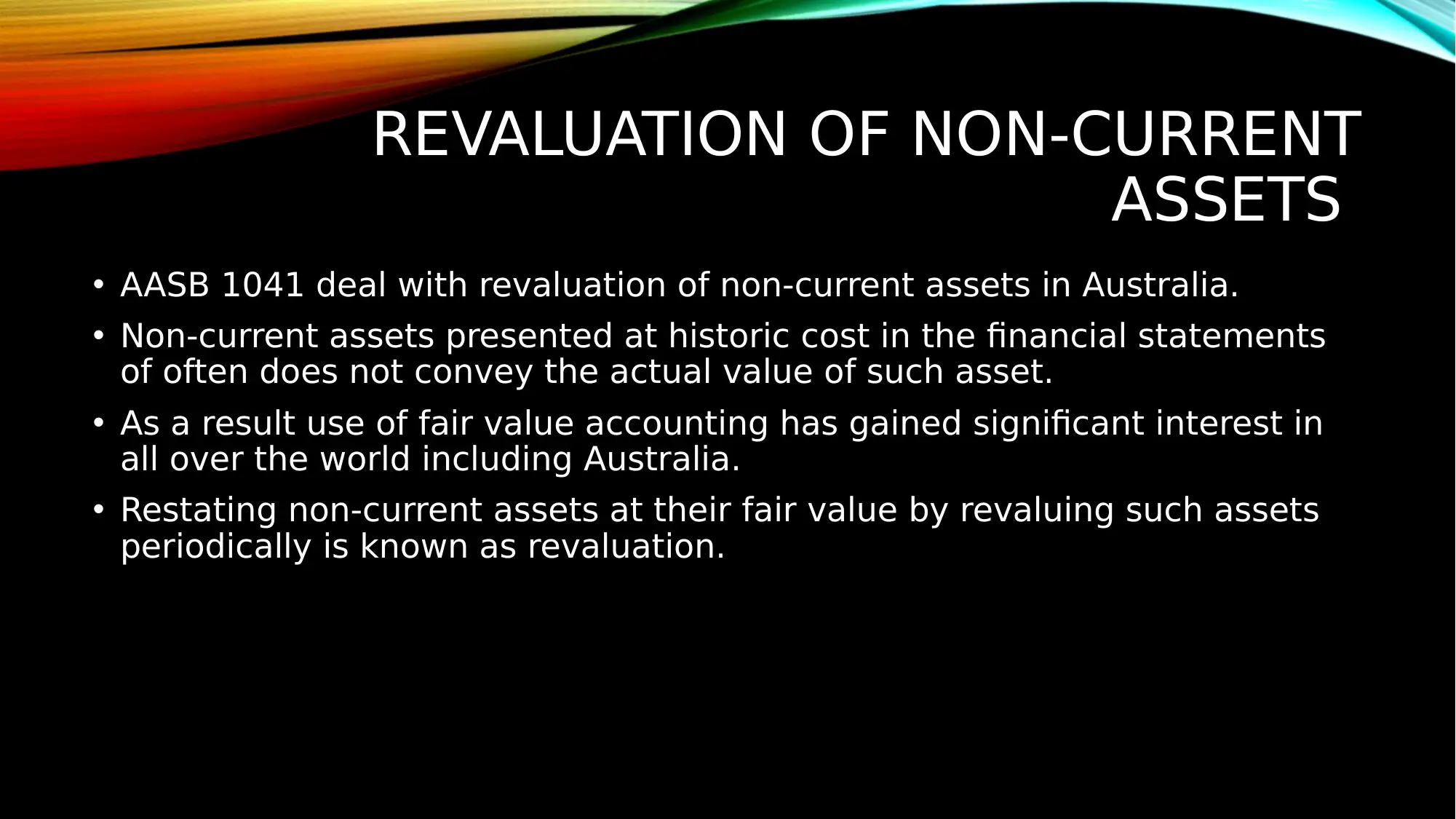
REVALUATION OF NON-CURRENT
ASSETS
• AASB 1041 deal with revaluation of non-current assets in Australia.
• Non-current assets presented at historic cost in the financial statements
of often does not convey the actual value of such asset.
• As a result use of fair value accounting has gained significant interest in
all over the world including Australia.
• Restating non-current assets at their fair value by revaluing such assets
periodically is known as revaluation.
ASSETS
• AASB 1041 deal with revaluation of non-current assets in Australia.
• Non-current assets presented at historic cost in the financial statements
of often does not convey the actual value of such asset.
• As a result use of fair value accounting has gained significant interest in
all over the world including Australia.
• Restating non-current assets at their fair value by revaluing such assets
periodically is known as revaluation.
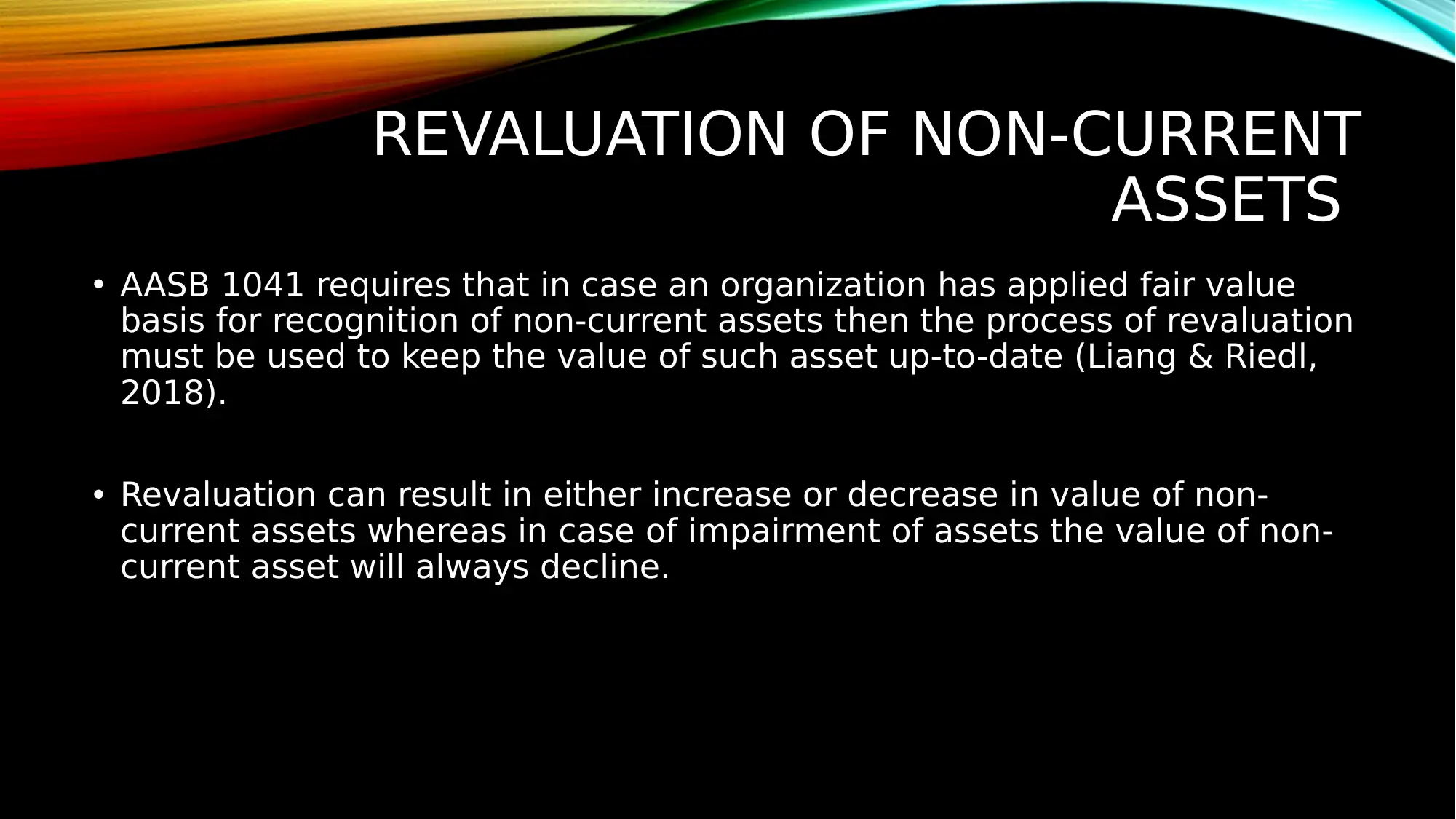
REVALUATION OF NON-CURRENT
ASSETS
• AASB 1041 requires that in case an organization has applied fair value
basis for recognition of non-current assets then the process of revaluation
must be used to keep the value of such asset up-to-date (Liang & Riedl,
2018).
• Revaluation can result in either increase or decrease in value of non-
current assets whereas in case of impairment of assets the value of non-
current asset will always decline.
ASSETS
• AASB 1041 requires that in case an organization has applied fair value
basis for recognition of non-current assets then the process of revaluation
must be used to keep the value of such asset up-to-date (Liang & Riedl,
2018).
• Revaluation can result in either increase or decrease in value of non-
current assets whereas in case of impairment of assets the value of non-
current asset will always decline.
⊘ This is a preview!⊘
Do you want full access?
Subscribe today to unlock all pages.

Trusted by 1+ million students worldwide
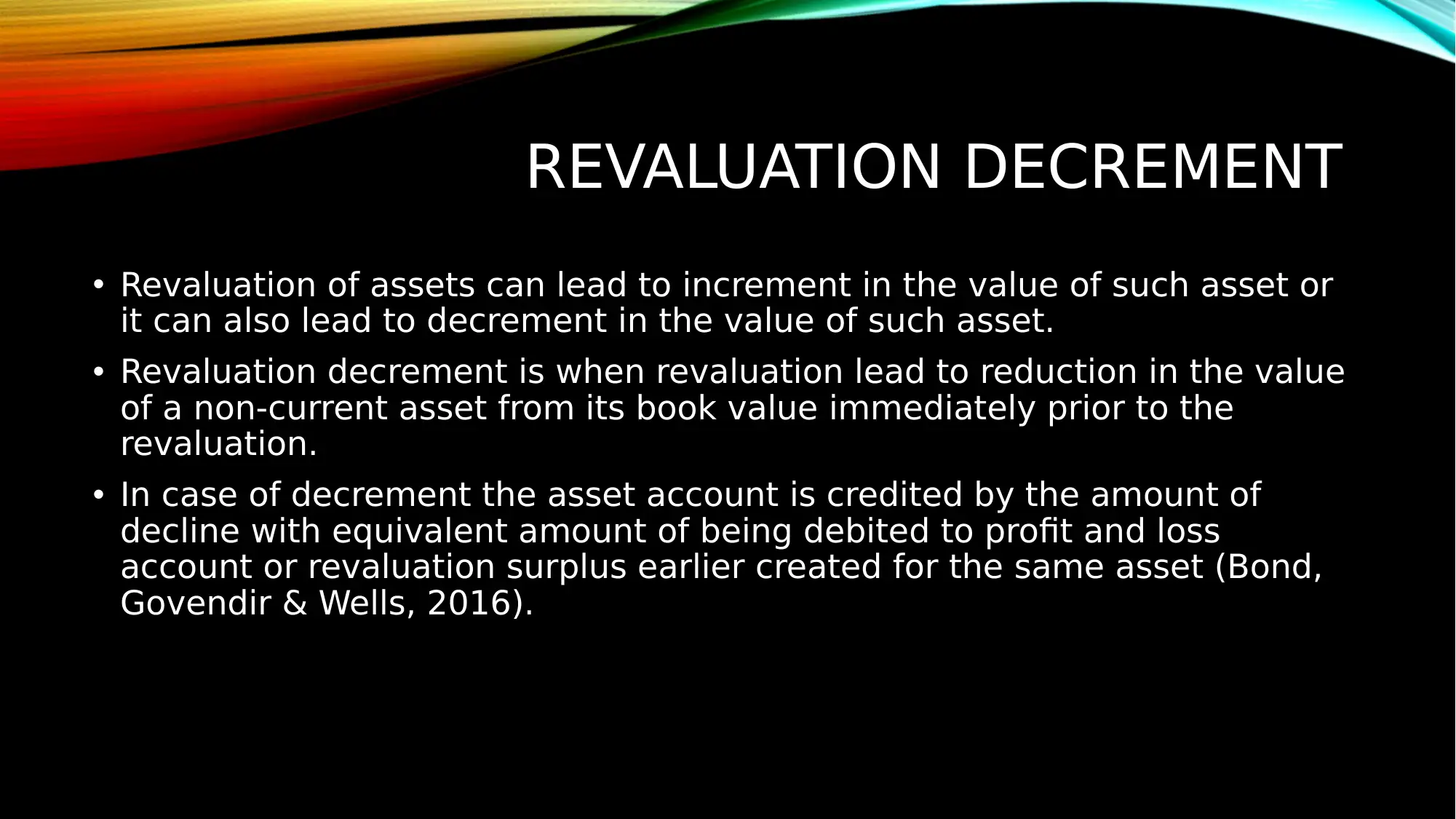
REVALUATION DECREMENT
• Revaluation of assets can lead to increment in the value of such asset or
it can also lead to decrement in the value of such asset.
• Revaluation decrement is when revaluation lead to reduction in the value
of a non-current asset from its book value immediately prior to the
revaluation.
• In case of decrement the asset account is credited by the amount of
decline with equivalent amount of being debited to profit and loss
account or revaluation surplus earlier created for the same asset (Bond,
Govendir & Wells, 2016).
• Revaluation of assets can lead to increment in the value of such asset or
it can also lead to decrement in the value of such asset.
• Revaluation decrement is when revaluation lead to reduction in the value
of a non-current asset from its book value immediately prior to the
revaluation.
• In case of decrement the asset account is credited by the amount of
decline with equivalent amount of being debited to profit and loss
account or revaluation surplus earlier created for the same asset (Bond,
Govendir & Wells, 2016).
Paraphrase This Document
Need a fresh take? Get an instant paraphrase of this document with our AI Paraphraser
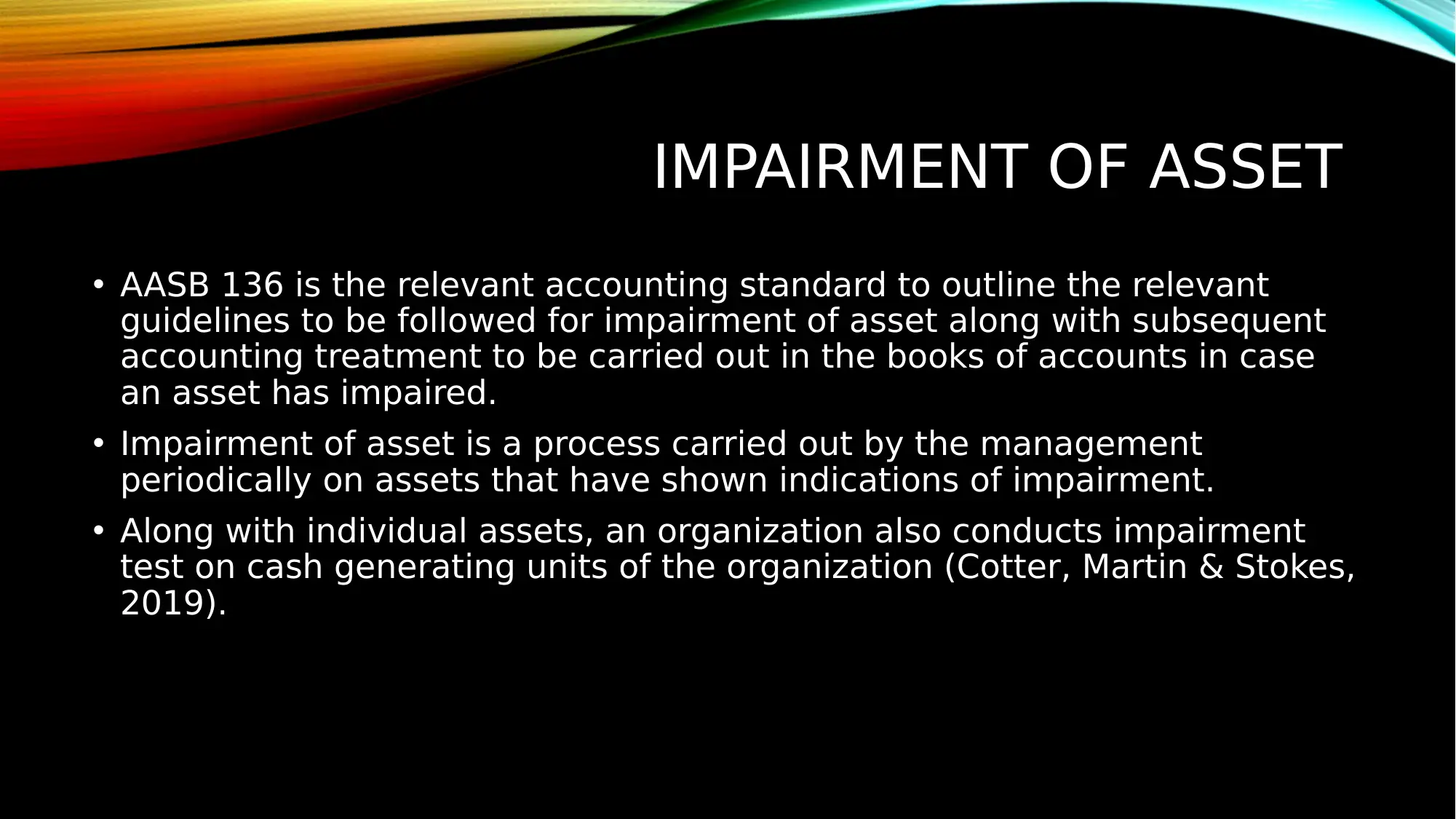
IMPAIRMENT OF ASSET
• AASB 136 is the relevant accounting standard to outline the relevant
guidelines to be followed for impairment of asset along with subsequent
accounting treatment to be carried out in the books of accounts in case
an asset has impaired.
• Impairment of asset is a process carried out by the management
periodically on assets that have shown indications of impairment.
• Along with individual assets, an organization also conducts impairment
test on cash generating units of the organization (Cotter, Martin & Stokes,
2019).
• AASB 136 is the relevant accounting standard to outline the relevant
guidelines to be followed for impairment of asset along with subsequent
accounting treatment to be carried out in the books of accounts in case
an asset has impaired.
• Impairment of asset is a process carried out by the management
periodically on assets that have shown indications of impairment.
• Along with individual assets, an organization also conducts impairment
test on cash generating units of the organization (Cotter, Martin & Stokes,
2019).
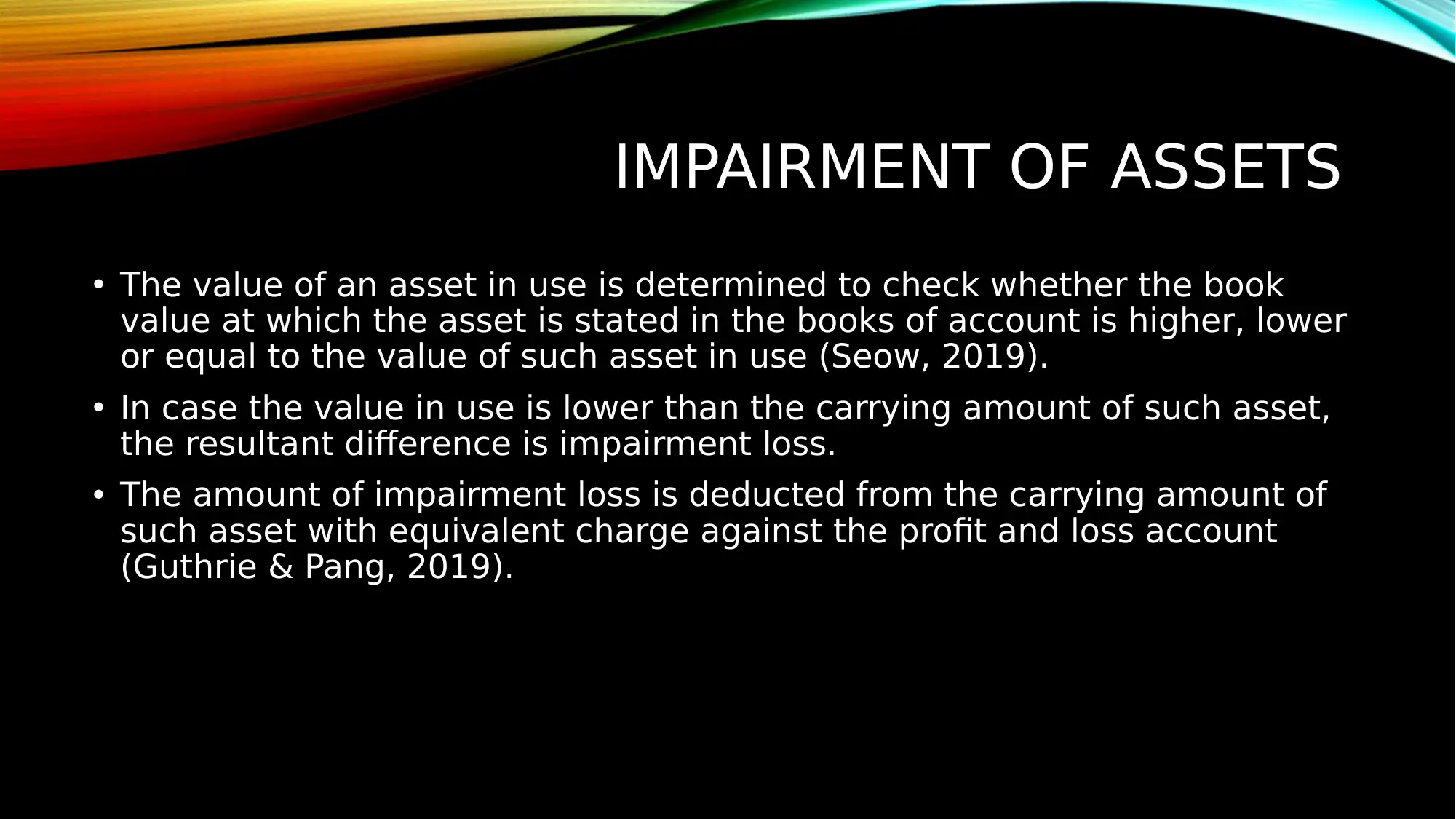
IMPAIRMENT OF ASSETS
• The value of an asset in use is determined to check whether the book
value at which the asset is stated in the books of account is higher, lower
or equal to the value of such asset in use (Seow, 2019).
• In case the value in use is lower than the carrying amount of such asset,
the resultant difference is impairment loss.
• The amount of impairment loss is deducted from the carrying amount of
such asset with equivalent charge against the profit and loss account
(Guthrie & Pang, 2019).
• The value of an asset in use is determined to check whether the book
value at which the asset is stated in the books of account is higher, lower
or equal to the value of such asset in use (Seow, 2019).
• In case the value in use is lower than the carrying amount of such asset,
the resultant difference is impairment loss.
• The amount of impairment loss is deducted from the carrying amount of
such asset with equivalent charge against the profit and loss account
(Guthrie & Pang, 2019).
⊘ This is a preview!⊘
Do you want full access?
Subscribe today to unlock all pages.

Trusted by 1+ million students worldwide
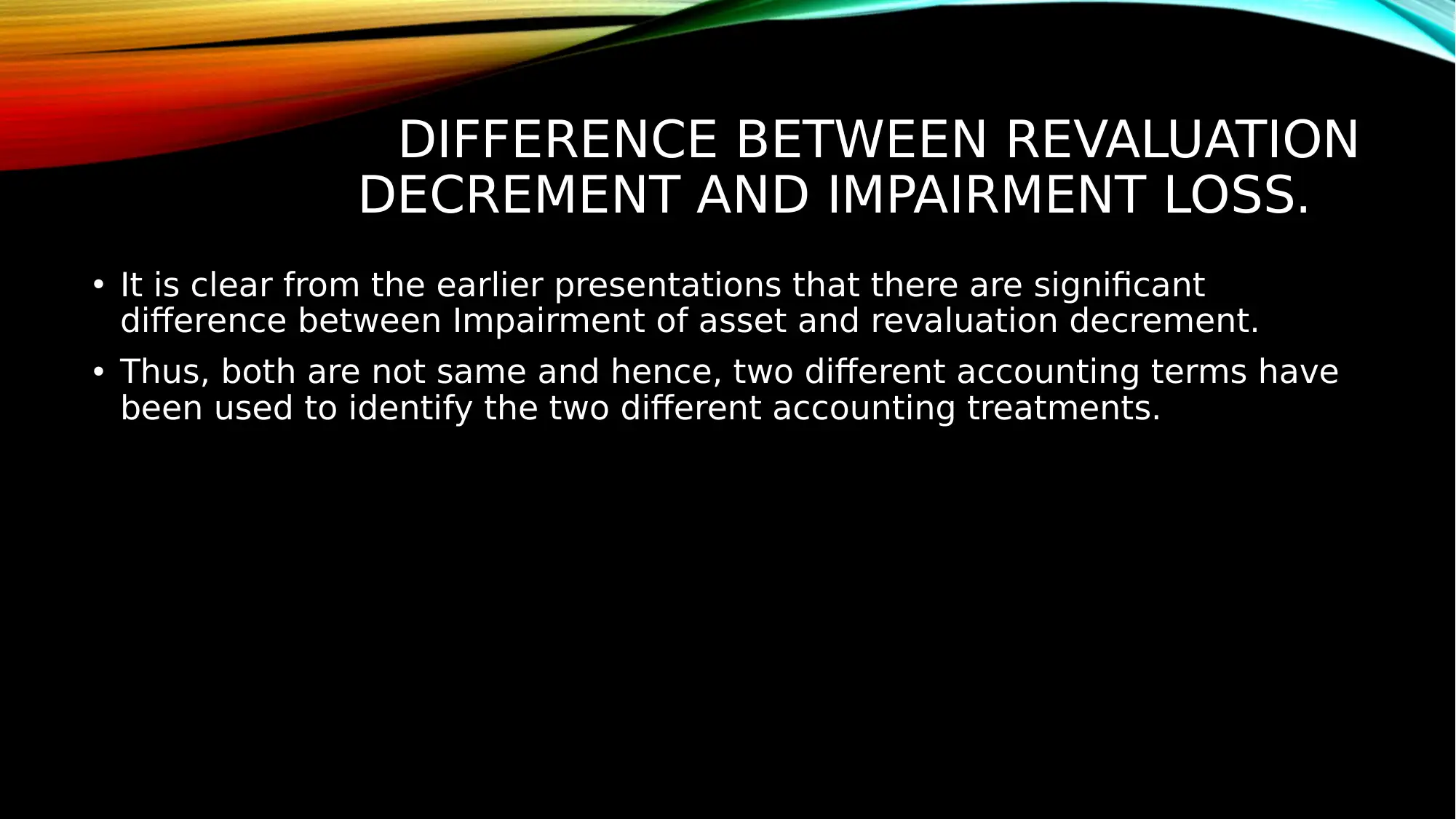
DIFFERENCE BETWEEN REVALUATION
DECREMENT AND IMPAIRMENT LOSS.
• It is clear from the earlier presentations that there are significant
difference between Impairment of asset and revaluation decrement.
• Thus, both are not same and hence, two different accounting terms have
been used to identify the two different accounting treatments.
DECREMENT AND IMPAIRMENT LOSS.
• It is clear from the earlier presentations that there are significant
difference between Impairment of asset and revaluation decrement.
• Thus, both are not same and hence, two different accounting terms have
been used to identify the two different accounting treatments.
Paraphrase This Document
Need a fresh take? Get an instant paraphrase of this document with our AI Paraphraser
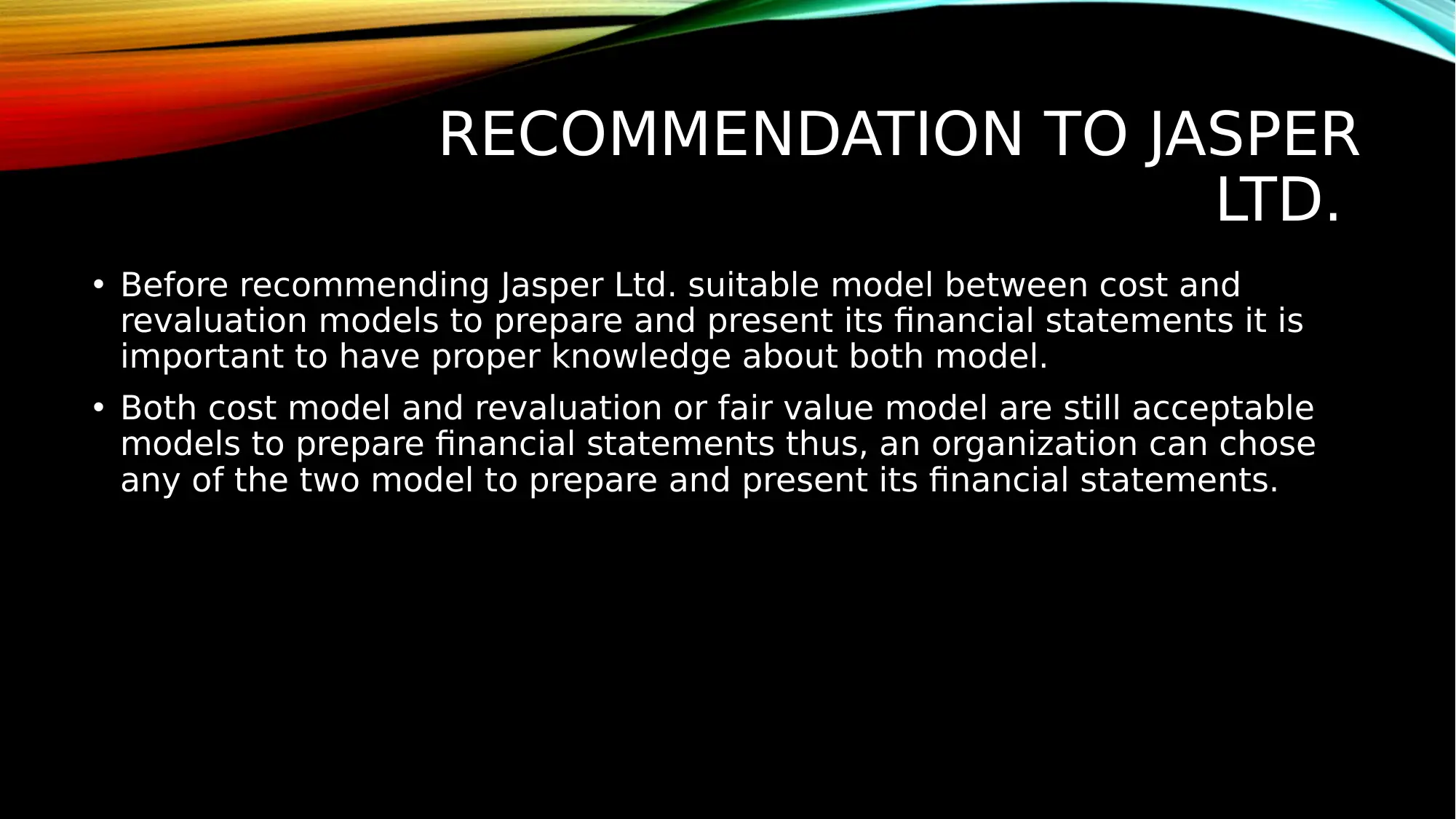
RECOMMENDATION TO JASPER
LTD.
• Before recommending Jasper Ltd. suitable model between cost and
revaluation models to prepare and present its financial statements it is
important to have proper knowledge about both model.
• Both cost model and revaluation or fair value model are still acceptable
models to prepare financial statements thus, an organization can chose
any of the two model to prepare and present its financial statements.
LTD.
• Before recommending Jasper Ltd. suitable model between cost and
revaluation models to prepare and present its financial statements it is
important to have proper knowledge about both model.
• Both cost model and revaluation or fair value model are still acceptable
models to prepare financial statements thus, an organization can chose
any of the two model to prepare and present its financial statements.
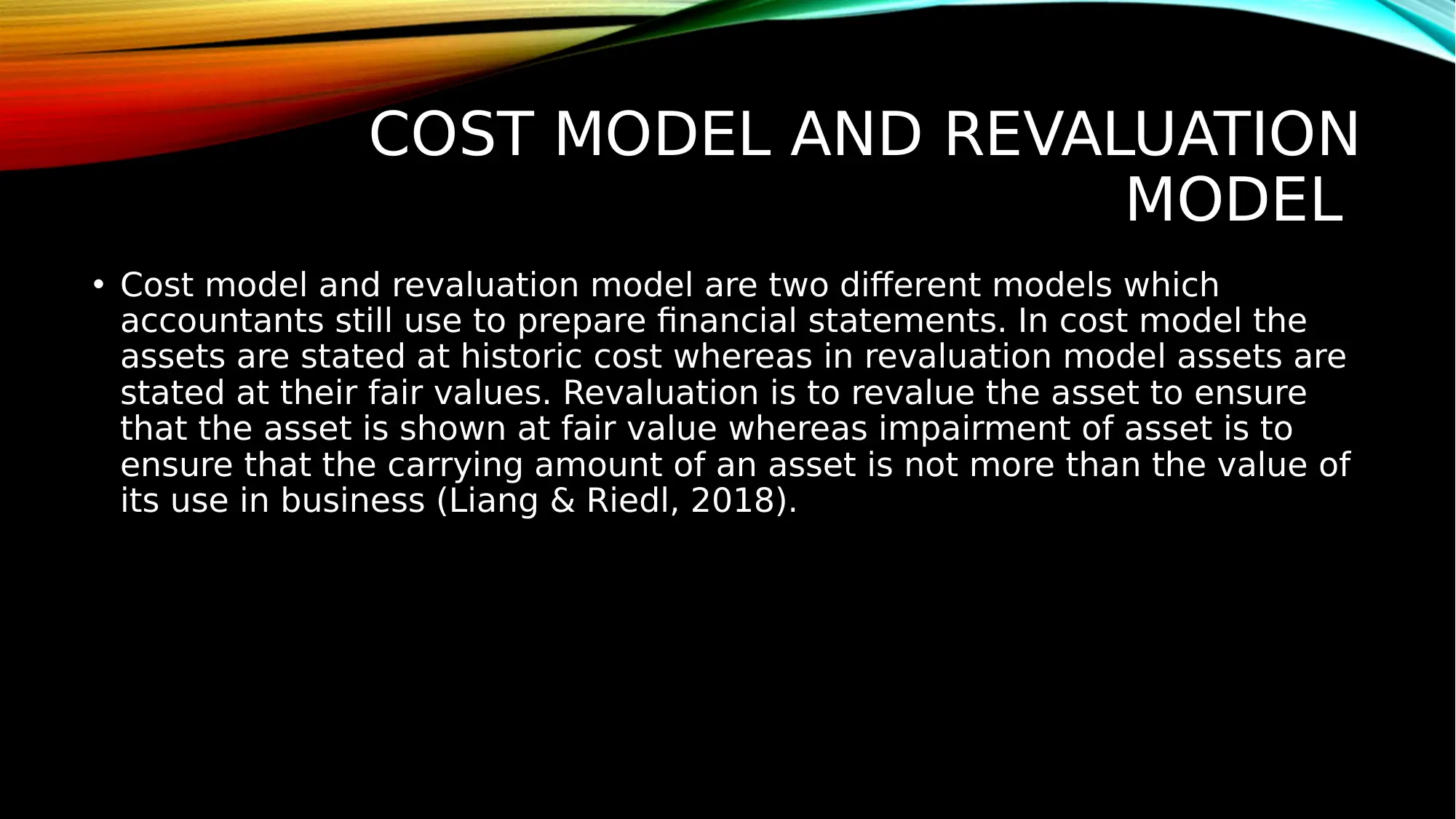
COST MODEL AND REVALUATION
MODEL
• Cost model and revaluation model are two different models which
accountants still use to prepare financial statements. In cost model the
assets are stated at historic cost whereas in revaluation model assets are
stated at their fair values. Revaluation is to revalue the asset to ensure
that the asset is shown at fair value whereas impairment of asset is to
ensure that the carrying amount of an asset is not more than the value of
its use in business (Liang & Riedl, 2018).
MODEL
• Cost model and revaluation model are two different models which
accountants still use to prepare financial statements. In cost model the
assets are stated at historic cost whereas in revaluation model assets are
stated at their fair values. Revaluation is to revalue the asset to ensure
that the asset is shown at fair value whereas impairment of asset is to
ensure that the carrying amount of an asset is not more than the value of
its use in business (Liang & Riedl, 2018).
⊘ This is a preview!⊘
Do you want full access?
Subscribe today to unlock all pages.

Trusted by 1+ million students worldwide
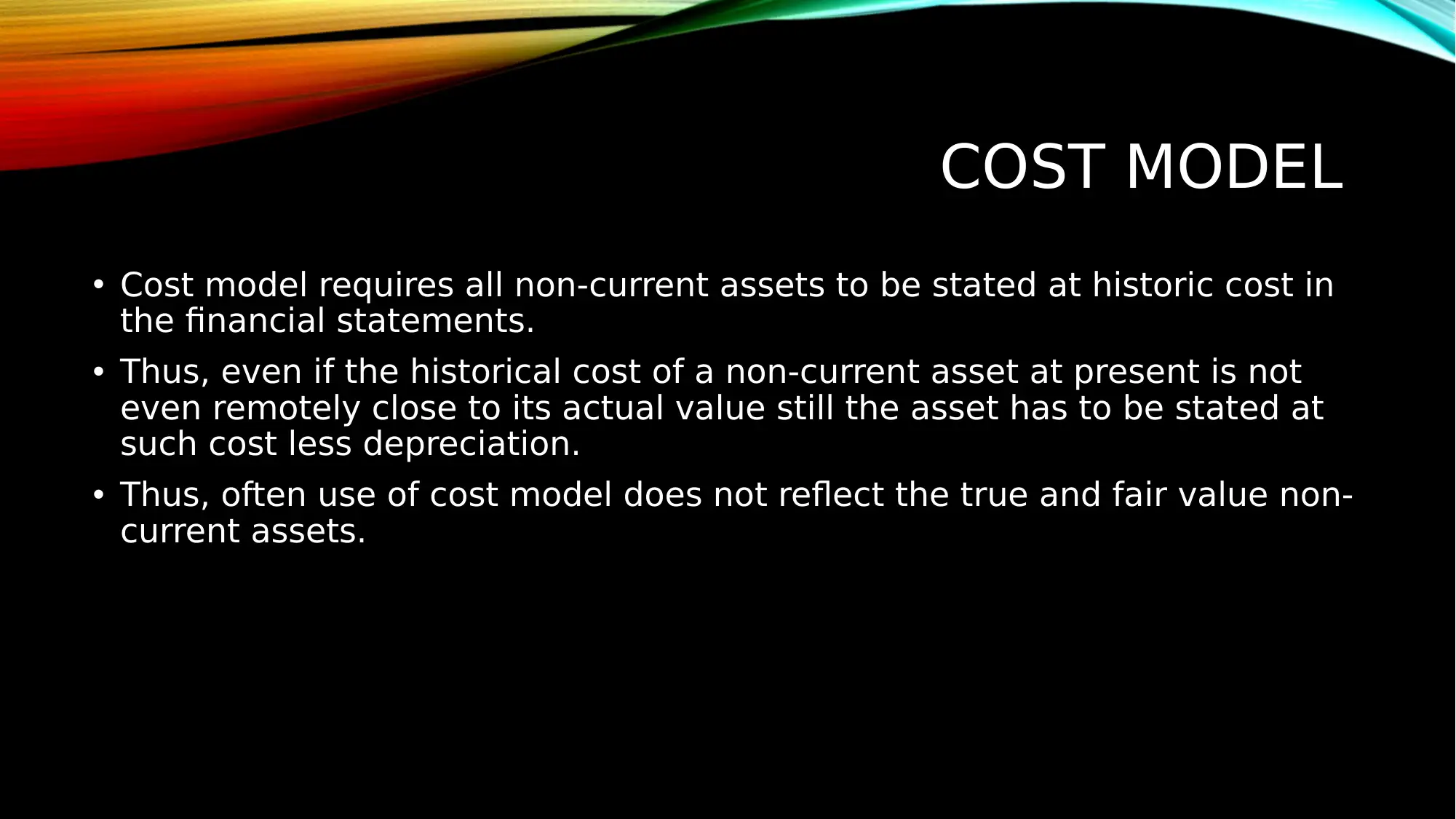
COST MODEL
• Cost model requires all non-current assets to be stated at historic cost in
the financial statements.
• Thus, even if the historical cost of a non-current asset at present is not
even remotely close to its actual value still the asset has to be stated at
such cost less depreciation.
• Thus, often use of cost model does not reflect the true and fair value non-
current assets.
• Cost model requires all non-current assets to be stated at historic cost in
the financial statements.
• Thus, even if the historical cost of a non-current asset at present is not
even remotely close to its actual value still the asset has to be stated at
such cost less depreciation.
• Thus, often use of cost model does not reflect the true and fair value non-
current assets.
Paraphrase This Document
Need a fresh take? Get an instant paraphrase of this document with our AI Paraphraser
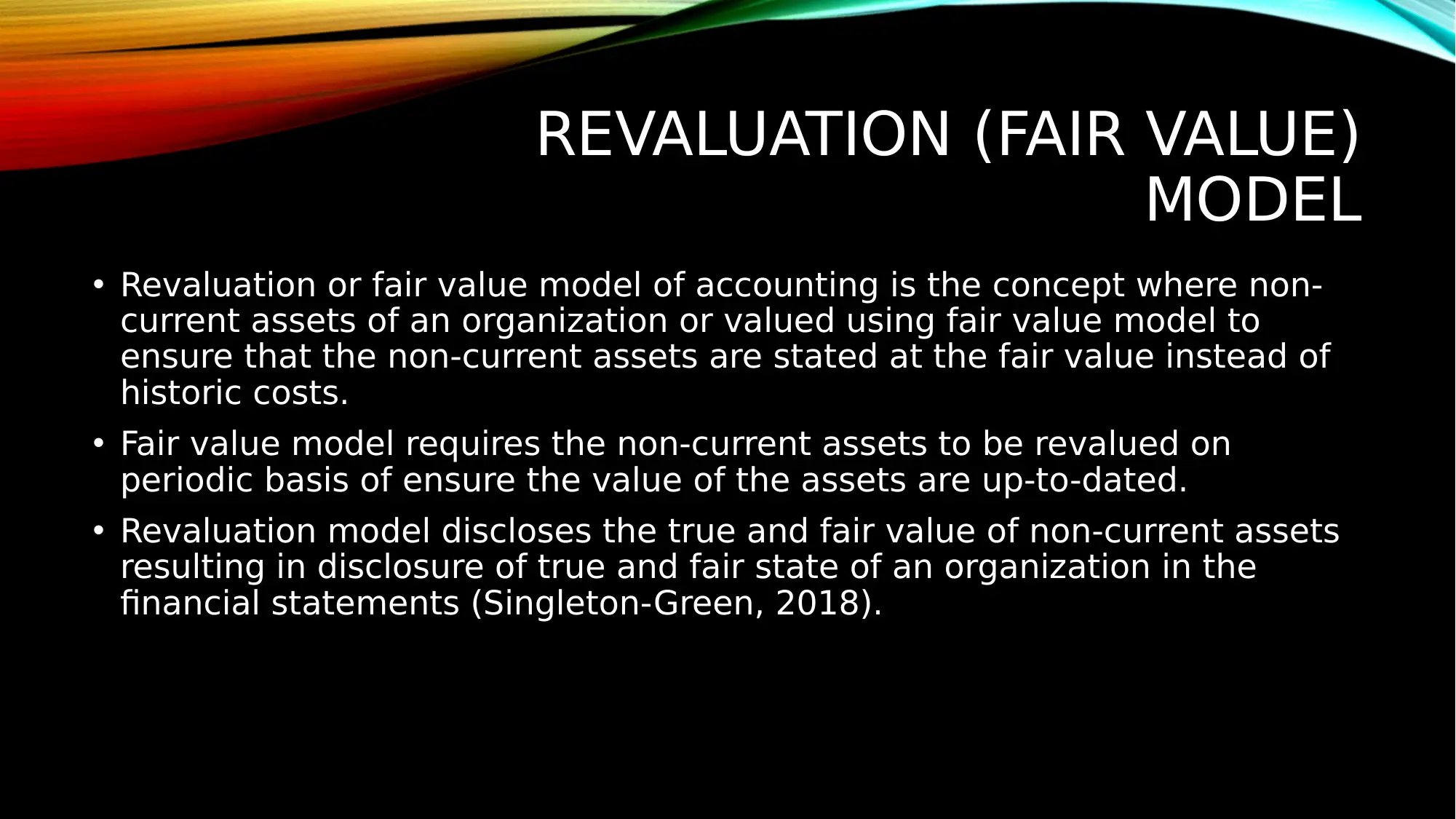
REVALUATION (FAIR VALUE)
MODEL
• Revaluation or fair value model of accounting is the concept where non-
current assets of an organization or valued using fair value model to
ensure that the non-current assets are stated at the fair value instead of
historic costs.
• Fair value model requires the non-current assets to be revalued on
periodic basis of ensure the value of the assets are up-to-dated.
• Revaluation model discloses the true and fair value of non-current assets
resulting in disclosure of true and fair state of an organization in the
financial statements (Singleton-Green, 2018).
MODEL
• Revaluation or fair value model of accounting is the concept where non-
current assets of an organization or valued using fair value model to
ensure that the non-current assets are stated at the fair value instead of
historic costs.
• Fair value model requires the non-current assets to be revalued on
periodic basis of ensure the value of the assets are up-to-dated.
• Revaluation model discloses the true and fair value of non-current assets
resulting in disclosure of true and fair state of an organization in the
financial statements (Singleton-Green, 2018).
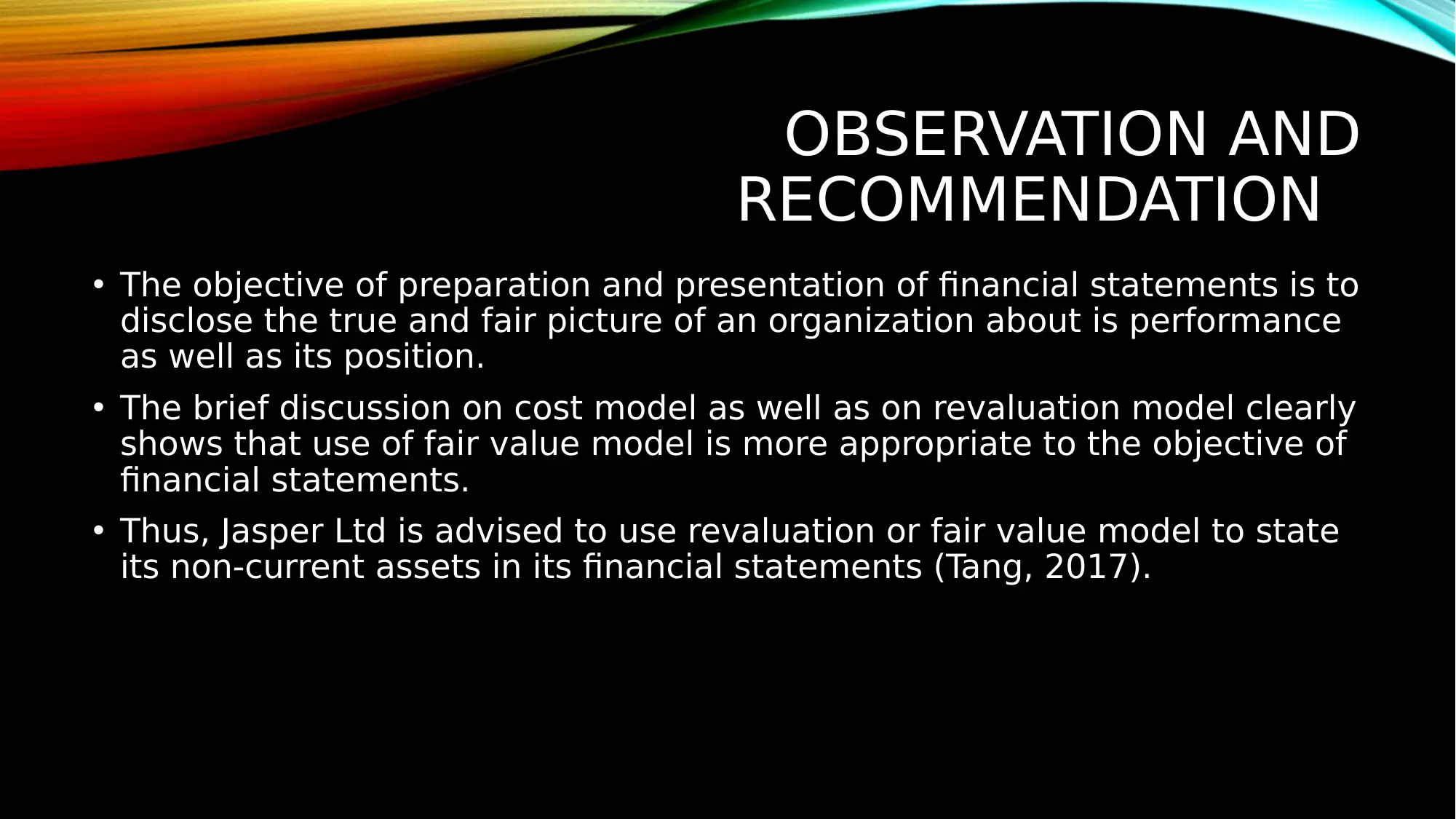
OBSERVATION AND
RECOMMENDATION
• The objective of preparation and presentation of financial statements is to
disclose the true and fair picture of an organization about is performance
as well as its position.
• The brief discussion on cost model as well as on revaluation model clearly
shows that use of fair value model is more appropriate to the objective of
financial statements.
• Thus, Jasper Ltd is advised to use revaluation or fair value model to state
its non-current assets in its financial statements (Tang, 2017).
RECOMMENDATION
• The objective of preparation and presentation of financial statements is to
disclose the true and fair picture of an organization about is performance
as well as its position.
• The brief discussion on cost model as well as on revaluation model clearly
shows that use of fair value model is more appropriate to the objective of
financial statements.
• Thus, Jasper Ltd is advised to use revaluation or fair value model to state
its non-current assets in its financial statements (Tang, 2017).
⊘ This is a preview!⊘
Do you want full access?
Subscribe today to unlock all pages.

Trusted by 1+ million students worldwide
1 out of 13
Related Documents
Your All-in-One AI-Powered Toolkit for Academic Success.
+13062052269
info@desklib.com
Available 24*7 on WhatsApp / Email
![[object Object]](/_next/static/media/star-bottom.7253800d.svg)
Unlock your academic potential
Copyright © 2020–2025 A2Z Services. All Rights Reserved. Developed and managed by ZUCOL.





